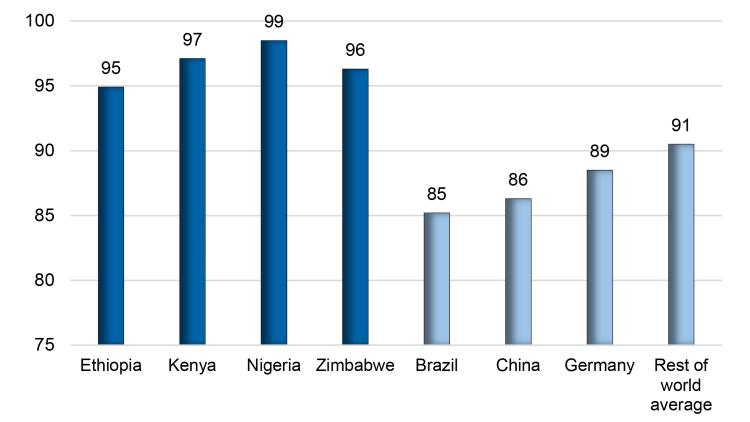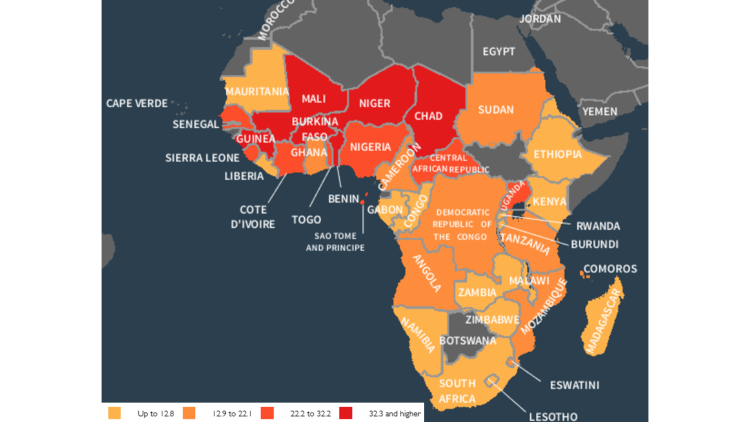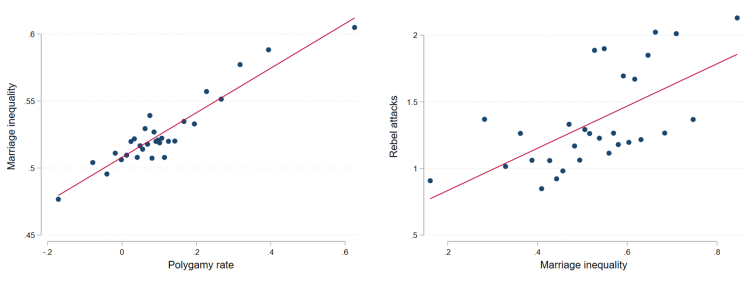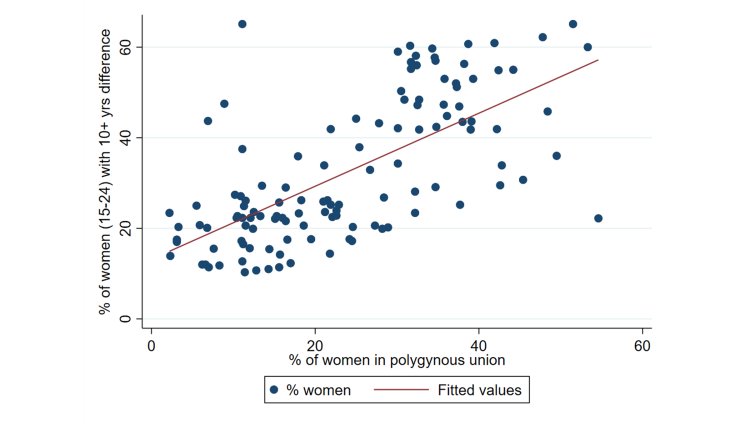- Startseite
- Publikationen
- GIGA Focus
- Happy Ever After? The Marriage Market as a Source of Societal Instability
GIGA Focus Afrika
Happy Ever After? The Marriage Market as a Source of Societal Instability
Nummer 4 | 2022 | ISSN: 1862-3603

There is a long-standing idea that societies with too many men, particularly young and single men – the so-called “bare branches” – have a tendency for vice, risk-taking and violence, ultimately threatening social order and stability.
Marriage is an important marker for adulthood across the globe. Yet, participation in the marriage market – looking for a spouse and forming a union – in sub-Saharan Africa is constrained, and the marriage market is an important institution shaping and maintaining inequality in income and opportunities.
Traditional marriage practices, such as that of polygyny, where one man is married to more than one woman at the same time, are still prevalent in sub-Saharan Africa and lead to a situation where some men, particularly the young, struggle to find a wife and start a family.
Having more men than women in the marriage market gives rise to competition amongst men, spurring frustration and anger among those that struggle to find a bride. The imbalance between men and women in the marriage market has been associated with increasing rebel attacks and intergroup conflict in the region. Hence, there is a palpable need to pay more attention to the marriage market, particularly in sub-Saharan African countries, many of which are already struggling with political and societal instability.
A more complete characterisation of the marriage market and its actors is necessary to better understand the underlying forces that cause young and unmarried men to gravitate towards violence.
Policy Implications
Governments must begin to recognise the importance of the marriage market as an institution perpetrating injustices and economic grievances. At the same time, targeted strategies need to be developed that recognise and address perceived inequalities and thus pre-empt promises by extremist groups, who exploit the relative dearth of brides as a recruitment strategy. Targeted information campaigns and appeals are only short-term solutions. Direct interventions in the marriage market might encounter pushback. New ways of thinking based on deeper research may be required.
The Marriage Market – A Perpetrator of Inequality
The importance of the family as a social institution is non-controversial. Yet, family formation and the role of the marriage market – with the exception of child marriage – are rarely the focus of researchers and practitioners thinking about economic development and policy in sub-Saharan Africa (SSA). This is despite the fact that marriage and family are still relatively more important to the people in the region than elsewhere in the world. Data from the latest World Value Surveys wave (2017–2020) illustrates this (Figure 1). Over 95 per cent of respondents in sampled sub-Saharan African countries respond that family is “very important” in their lives. This compares to about 85 per cent of respondents in Brazil and China, and just below 90 per cent in Germany.

Figure 1. Percentage of Respondents Who Indicated that Family Is “Very Important” in Their Lives
Source: Author’s own representation of data from the 2017–2020 wave of the World Value Surveys.
Marriage markets are an important determinant of human capital investments, labour force participation, risk-sharing opportunities, and fertility outcomes (Chiappori, Meghir, and Costa Dias 2018; Rossi 2019). The academic literature, with a focus on the United States, has long recognised that searching and matching in the marriage market – the process through which couples meet and a union is formed – does have important implications for income inequality. Assortative mating – a situation whereby marriage is entered into by people of similar backgrounds, represented by qualities such as educational attainment or financial means – tends to not only mechanically amplify inequality between individuals but also carries inequalities forward to future generations. Because parents endowed with a larger stock of human capital invest more in their children, inequality carries over to the next generation. A lot of research on the marriage market in high-income countries is motivated by the role the marriage market plays for income distribution and inequality. In comparison, we have little knowledge about the workings of marriage markets and search and matching in middle- and low-income countries in general, and in sub-Saharan Africa in particular, even though inequality in income and opportunities are also pertinent concerns to policymakers there. A recent study by Pesando (2021) shows that educational assortive mating is practised throughout SSA, with particularly low-educated individuals increasingly sorting into homogeneous unions and thus carrying forward income inequality.
The marriage market in sub-Saharan Africa is further complicated by traditional marriage practices such as the “bride price” – payments from the groom to the bride upon marriage – and polygyny – the practice of one man being married to more than one woman. Polygyny is still a prevalent practice in SSA. In the polygyny belt – the region spanning from Senegal to Uganda – at least every fourth woman is in a polygynous union (Figure 2). The practice of polygyny is problematic for a number of reasons: Research has shown that the practice is detrimental to women, with negative consequences for female empowerment, education, and health, and it is an important determinant of the still high population growth in SSA (Rossi 2019; Tertilt 2006; Wagner and Rieger 2015). Furthermore, there is a longstanding notion that the practice of polygyny promotes violence and societal instability. Of the 18 sub-Saharan African countries on the 2022 list of fragile and conflict-affected states released by the World Bank, 13 have polygyny rates above the regional mean of 20 per cent. Furthermore, Krieger and Renner (2020) show that polygyny correlates positively with social unrest across 41 African countries. However, why should polygyny lead to instability?

Figure 2. Share of Women with One or More Co-Wives
Source: Author’s own representation based on data from the latest Demographic and Health Survey (DHS) data of the respective country.
The putative link between polygyny and instability may lie in the marriage market. Starting from a situation of gender parity at birth, it seems self-evident that if some men have more than one wife, other men will naturally be “deprived” of a bride. In sub-Saharan Africa, where the social status of men depends on having a family, such deprivation can be particularly dire, leading young men to gravitate towards (organised) violence. Being unmarried, these young men have low opportunity costs or simply less to lose by banding together and committing crimes, unrest, or violence. Inequality is also a key issue here. If brides are scarce, bride prices rise. This puts increasing pressure on men to accumulate wealth to be competitive in the marriage market, which further disadvantages those from poorer backgrounds. With few formal employment opportunities, crime, plundering, and violence might be the only options men can envision to acquire wealth and brides (Hudson and Matfess 2017). Terrorist groups, such as Boko Haram in Nigeria, exploit this situation, promising brides to their primary recruits – young, unmarried men. In a system in which having one’s own family is something greatly aspired to, but which is heavily constrained by poverty, lack of access to credit, and the relative shortage of women in the marriage market, frustration and anger might be natural by-products and ultimately also the foundation upon which the observed relationship between polygyny and instability rests.
How Angry Are Young Men?
There is indeed a small body of research from Asia that finds that the shortage of women in the marriage market positively associates with young men turning to crime and insurrection (Edlund et al. 2013; Hudson and den Boer 2002). In Asia, however, the imbalance in the marriage market does not stem from the marriage practice of polygyny but is a result of strong preference for sons and sex-selective abortion, leading to a male overhang at birth. In India and China, for example, there are currently approximately 110 (India) or 112 (China) male children born for every 100 female children. Hence, as these male cohorts mature, they face more competition over the relatively few women on the marriage market. Another piece of evidence comes from Germany. Women from the Eastern federal states migrate more often than men to the wealthier Western states, leaving many rural communities with a surplus of men of marriage age. Dancygier et al. (2022) link the male surplus in Germany’s Eastern federal states to an increase in hate crimes following the 2015 refugee influx. The authors propose that this is driven by an increase in mate competition with the male refugees entering local marriage markets.
There is also evidence from sub-Saharan Africa. Evidence here concentrates on group-level interactions. Koos and Neupert-Wentz (2020), for example, show that polygyny promotes intergroup, non-state conflict whereby polygynous ethnic groups with excess men are more likely than monogamous groups to raid, plunder, and rob their monogamous neighbours. The authors provide further evidence that underlying the higher readiness for conflict are feelings of inequality and anger. Using data from the 2005 Afrobarometer they show that young men (without offspring) who belong to polygynous groups feel that they are treated more unequally and are readier to use violence in comparison to those belonging to monogamous groups. A second piece of evidence comes from Rexer (2022), who links the inequality induced by polygyny to an increasing incidence of attacks by Boko Haram in Nigeria. This relationship seems to hold across sub-Saharan Africa. Figure 3 is a replication from his paper based on data from Demographic and Health Surveys from 1997 to 2016, covering 25,000 communities across 24 sub-Saharan African countries. The left-hand panel shows that a higher rate of polygyny indeed correlates positively with a higher inequality in the number of wives (measured by marriage inequality). Higher inequality, in turn, seems to be linked to higher numbers of rebel attacks (right-hand panel). The fact that such observations are global in nature suggests that researchers and policymakers should pay more attention to the marriage market as a key source of instability and conflict. Yet, one qualification should be made: The existing empirical evidence concentrates on the group level. To date we still lack individual-level data on the extent to which an imbalance in the marriage market triggers frustration and anger in young, unmarried men – an important piece of information upon which the theoretical argument linking the marriage market to instability rests.

Figure 3. Polygyny, Marriage Inequality, and Rebel Attacks in Sub-Saharan Africa
Source: Rexer (2022) based on data from 24 sub-Saharan African countries.
Understanding the Marriage Market and Its Imbalance
The existing discourse linking the marriage market to instability has taken a static view, failing to acknowledge that a number of factors, such as men’s higher risk of mortality and higher migration rates, might actually lead to a reduction of the imbalance in the marriage market. Furthermore, we also know that men usually marry younger women – this is true in every country of the world for which data is available. In the absence of population growth, the age gap might not matter much. But the story is totally different in the context of high population growth. In sub-Saharan Africa birth cohorts currently keep growing, at 2 to 3 per cent per year. If the age gap at marriage is five years, the cohort of men born in a given year will be matched with the cohort of women born five years later, and the latter cohort will be 10 to 15 per cent larger (if the sex ratio within each cohort is balanced). Hence, population growth and an increasing age gap between spouses might offset or at least reduce the perceived marriage market imbalance under a static perspective.
However, there is still some indication that marriage markets are out of tune and widening age gaps might actually be one indicator of this. If men do not have enough women to marry in their own age cohort, they might resort to marrying younger women. Data from the Demographic and Health Surveys lends support to this idea by showing that higher shares of polygyny are associated with rising age gaps between spouses (Figure 4). Table 1 below also illustrates this by looking at the situation in selected West African countries. In Burkina Faso, Côte d’Ivoire, and Senegal at least four in ten women are more than 10 years younger than their spouses. Widening age gaps are in themselves problematic as they preserve the practice of child marriage and have negative implications for female bargaining power, empowerment, and health.
The data in Table 1 makes one additional point: While almost 95 per cent of women are married by age 29 in Burkina Faso, only 65 per cent of men are also in union by this age. Differences are equally stark in Côte d’Ivoire and Senegal. Yet, we also observe substantial catch-up in the rates by age 35, with over two thirds of men also married by this age. On the one hand, this is just another representation of the widening age gap and of men marrying at a later age, but on the other hand, it is also suggestive of a situation in which the lack of opportunity in the marriage market might be only temporal, at least from an individual perspective. This view corroborates qualitative evidence from Burkina Faso, where young men express that if they remain unmarried by the age of 30 to 35 the family will start looking for a bride for them. Hence, an alternative narrative of the issue could be that it is not the marriage market imbalance per se which spurs frustration and anger but the uncertainty it creates with respect to the timing of marriage and the “quality” of the potential wife. This is very different rhetoric vis-à-vis the existing proposition, and implies that concerns about singlehood and the marriage prospects used by extremist groups as part of their recruitment strategies could be pre-empted through better information.

Figure 4. Relationship between Polygyny and Age Gap of Spouses
Source: Author’s own representation based on data from the latest Demographic and Health Survey (DHS) data of the respective country.

Table 1. Share of Married Women and Men (by age, selected countries)
Source: Data on age group comes from the UN World Marriage Data 2019; data on age gap comes from the most recent DHS data.
Notes: Age group refers to the percentage of ever-married by age group. Age gap gives the percentage of currently married women ages 15–24 with the respective age difference to their husbands.
Policy Should Recognise Inequalities
If polygyny is indeed a driver of marriage market inequalities, banning the practice might be the logical policy response. Indeed, polygyny is currently banned in 16 of the 46 sub-Saharan African countries. Yet, de facto, it is still practised in 11 of the 16. Hence, further bans of polygyny might be of no effect. In Africa, polygyny persists and is socially acceptable despite Westernisation and is little responsive to education. Hence, relying on the practice to disappear as education levels rise – an argument that we often hear in the context of female empowerment or labour force participation – might be overly optimistic in this context.
Generally, to disentangle the effects, to explore potentially mutually enforcing inequalities, and to address individual-level mechanisms, a better understanding of (local) marriage markets is necessary. There is the oft-maintained view that the instability originating from young and unmarried men stems from a lack of economic opportunities and that providing youth with work opportunities would contribute to security and reduce their vulnerability to extremist recruitment. The current article does not attempt to downplay the importance and potential of employment, especially given the close interlinkages between the labour market and marriage market opportunities. Yet, the idea that risks emerging from unmarried young men could be solved through employment is, in practice, a far-fetched argument. Responses such as extensive training and workfare programmes targeted at youths, which are time- and resource-intensive, have had little to no effect, as examples from Liberia and Côte d’Ivoire show (see Bertrand et al. 2021; Blattman and Annan 2016). Targeted information campaigns and appeals to youth to pre-empt violent group activities might represent only short-term solutions.
To address the potential of social instability emerging from an imbalanced marriage market, policy needs to recognise the existing inequalities and concentrate on (re-)establishing a basic social contract between the communities and those “deprived” of brides. Research needs to delve deeper to try to understand exactly to what extent marriage market inequalities are a problem, as well as where and why. Based on these more detailed insights, new thinking on policy responses will be needed.
Fußnoten
References
Bertrand, Marianne, Bruno Crépon, Alicia Marguerie, and Patrick Premand (2021), Do Workfare Programs Live Up to Their Promises? Experimental Evidence from Côte d’Ivoire, accessed 18 April 2022.
Blattman, Christopher, and Jeannie Annan (2016), Can Employment Reduce Lawlessness and Rebellion? A Field Experiment with High-Risk Men in a Fragile State, in: American Political Science Review, 110, 1, 1–17.
Chiappori, Pierre-André, Monica Costa Dias, and Costas Meghir, (2018), The Marriage Market, Labor Supply and Education Choice, in: Journal of Political Economy, 126, S1, S26–S72.
Dancygier, Rafaela, Naoki Egami, Amaney Jamal, and Ramona Rischke (2022), Hate Crimes and Gender Imbalances: Fears over Mate Competition and Violence against Refugees, in: American Journal of Political Sciences, 66, 2, 501–515.
Dhillon, Navtej, and Tarik M. Yousef (eds) (2009), Generation in Waiting: The Unfulfilled Promise of Young People in the Middle East, New York: Brookings Institution Press.
Edlund, Lena, Hongbin Li, Junjian Yi, and Junsen Zhang (2013), Sex Ratios and Crime: Evidence from China, in: Review of Economics and Statistics, 95, 5, 1520–1534.
Hudson, Valerie, and Andrea Den Boer (2002), A Surplus of Men, a Deficit of Peace: Security and Sex Ratios in Asia’s Largest States, in: International Security, 26, 4, 5–38.
Hudson, Valerie, and Hilary Matfess (2017), In Plain Sight: The Neglected Linkage between Brideprice and Violent Conflict, in: International Security, 42, 1, 7–40.
Koos, Carlo, and Clara Neupert-Wentz (2020), Polygynous Neighbors, Excess Men, and Intergroup Conflict in Rural Africa, in: Journal of Conflict Resolution, 64, 2–3, 402–431.
Krieger, Tim, and Laura Renner (2020), Polygyny, Inequality, and Social Unrest, accessed 10 March 2022.
Pesando, Luca Maria (2021), Educational Assortative Mating in Sub-Saharan Africa: Compositional Changes and Implications for Household Wealth Inequality, in: Demography, 58, 2, 571–602.
Rexer, Jonah (2022), The Brides of Boko Haram: Economic Shocks, Marriage Practices, and Insurgency in Nigeria, in: The Economic Journal, accessed 10 March 2022.
Rossi, Pauline (2019), Strategic Choices in Polygamous Households: Theory and Evidence from Senegal, in: The Review of Economic Studies, 86, 3, 1332–1370.
Tertilt, Michèle (2006), Polygyny, Women’s Rights, and Development, in: Journal of the European Economic Association, 4, 2–3, 523–530.
Wagner, Natascha, and Matthias Rieger (2015), Polygyny and Child Growth: Evidence from Twenty-Six African Countries, in: Feminist Economics, 21, 2, 105–130.
Gesamtredaktion GIGA Focus
Redaktion GIGA Focus Afrika
Lektorat GIGA Focus Afrika
Forschungsprojekt
Regionalinstitute
Forschungsschwerpunkte
Wie man diesen Artikel zitiert
Hartwig, Renate (2022), Happy Ever After? The Marriage Market as a Source of Societal Instability, GIGA Focus Afrika, 4, Hamburg: German Institute for Global and Area Studies (GIGA), https://doi.org/10.57671/gfaf-22042
Impressum
Der GIGA Focus ist eine Open-Access-Publikation. Sie kann kostenfrei im Internet gelesen und heruntergeladen werden unter www.giga-hamburg.de/de/publikationen/giga-focus und darf gemäß den Bedingungen der Creative-Commons-Lizenz Attribution-No Derivative Works 3.0 frei vervielfältigt, verbreitet und öffentlich zugänglich gemacht werden. Dies umfasst insbesondere: korrekte Angabe der Erstveröffentlichung als GIGA Focus, keine Bearbeitung oder Kürzung.
Das German Institute for Global and Area Studies (GIGA) – Leibniz-Institut für Globale und Regionale Studien in Hamburg gibt Focus-Reihen zu Afrika, Asien, Lateinamerika, Nahost und zu globalen Fragen heraus. Der GIGA Focus wird vom GIGA redaktionell gestaltet. Die vertretenen Auffassungen stellen die der Autorinnen und Autoren und nicht unbedingt die des Instituts dar. Die Verfassenden sind für den Inhalt ihrer Beiträge verantwortlich. Irrtümer und Auslassungen bleiben vorbehalten. Das GIGA und die Autorinnen und Autoren haften nicht für Richtigkeit und Vollständigkeit oder für Konsequenzen, die sich aus der Nutzung der bereitgestellten Informationen ergeben.









